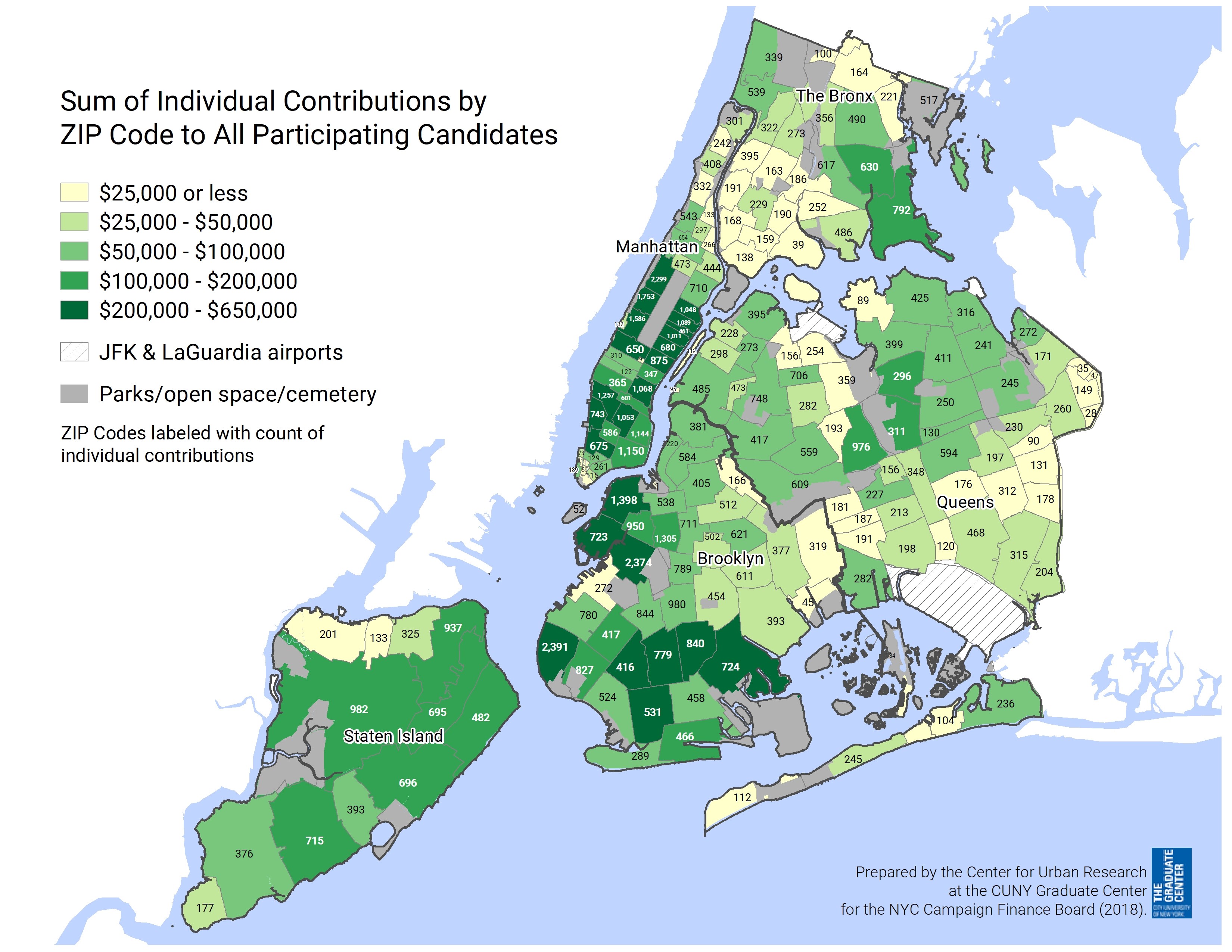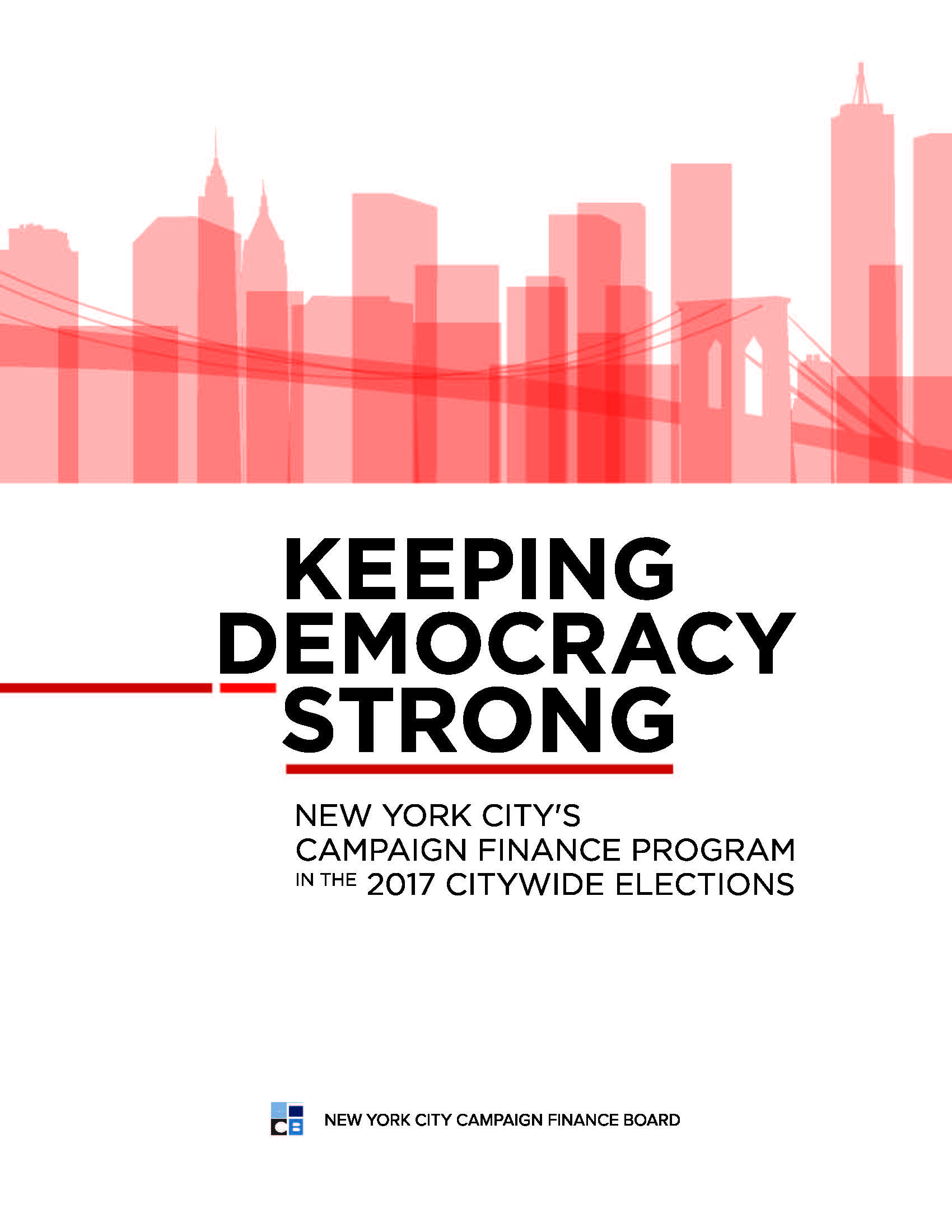2017 Post-Election Report
New York City's landmark Campaign Finance Program has shaped the landscape of city elections and strengthened New Yorkers’ relationship to their government since 1988.
The CFB’s comprehensive report on the 2017 citywide elections shows that small-dollar contributors played a larger role in city elections than ever before. Key findings of the report include:
Small-dollar contributors (those who gave $175 or less) played a larger role in New York City’s 2017 elections than in either the 2009 or 2013 elections.
- 73 percent of all contributors to candidates for mayor gave $175 or less.
- In 2013, small-dollar contributors were just 48 percent of contributors to mayoral campaigns.
- In 2009, small-dollar contributors were 70 percent of contributors to mayoral candidates.
More candidates conducted small-dollar fundraising online.
- The CFB’s NYC Votes Contribute application (nycvotes.org) allowed candidates to recruit small-dollar supporters via the web, social media, and email.
- Candidates raised over 27,000 contributions, totaling nearly $4.4 million, via NYC Votes Contribute.
- For the first time in the Program’s history, more contributions were made by credit card than by check.
Those small contributions were amplified through public matching funds.
- Eligible candidates received $17.7 million in public funds payments in 2017.
- For the second election cycle in a row, both major party nominees for mayor participated in the matching funds program and received $5.9 million in matching funds.
- City Council candidates received more than 50 percent of their funds from the public match.
With public funds available to candidates, NYC’s municipal elections are more often contested or competitive than state legislative races.
- In the 2017 races for City Council, five of 41 incumbents (12 percent) faced no opposition in the primary or general election, while 26 percent of incumbents in the State Assembly and Senate representing New York City were re-elected in 2016 without an opponent.
- For City Council, 12 of 51 races (24 percent) were competitive (meaning the winner received less than 50 percent of vote); by that standard, only one local race for the state legislature was competitive in 2016.
The report also includes specific proposals to build on the Program’s successes and improve the system. The Board’s proposals focus particularly on the citywide offices where large contributions continue to play a large role in funding campaigns.
The proposals include:
- Lowering the contribution limits.
- Increasing the matching ratio for citywide candidates.
- Increasing the amount of public funds candidates are eligible to receive.
- Making it easier for citywide candidates to qualify for public funds.
The report includes important updates about the Board’s administration of the Campaign Finance Program, including outlines of changes to the post-election audit process for the 2017 elections and a summary of enforcement actions for the 2013 election cycle.
Other sections of the report include:
- Profiles of the most interesting races of the 2017 elections in “At the Races.”
- In-depth analysis of campaign finance data from the 2017 elections—including maps produced by the Center for Urban Research at the CUNY Graduate Center.
- A close look at independent expenditures and contributions from individuals doing business with city government.
- A review of the Campaign Finance Board’s voter education and engagement efforts for the 2017 elections through its NYC Votes initiative.
- A survey of innovations and improvements to the services the CFB provides for candidates.


Appendices
- Appendix A: Candidates in the 2017 Elections


- Appendix A-1: Campaign Finance Program Participants in the 2017 Elections


- Appendix B: Totals for Candidates Appearing on the Primary Election Ballot


- Appendix C: Totals for Candidates Appearing on the General Election Ballot


- Appendix D: Contributions and Other Receipts


- Appendix E: Contributions by Type of Contributor


- Appendix F: Loans


- Appendix G: Total Expenditures by Expenditure Limit Period


- Appendix H: Candidate Payments Summary (Participants Only)


- Appendix I: Candidates’ Financial Summary


- Appendices Notes – a description of the information contained in each appendix

- Appendices Keys – outlines information in each column within each appendix

Underlying Datasets










